Best Web Hosting Plans 2024: Shared, VPS, WordPress and Cloud
We’ve tested the major hosting providers to help you find the right one for your needs.

Whether you’re putting up a page just to show off your resume and family photos, you’re building data-driven online tools, or you’re promoting a small business, you need a web hosting service to serve your site. The good news is that there are dozens of web hosting companies competing for your business and each of them has a variety of plans at different price points.
To help you find the best web hosting plan for your personal or business website, we’ve tested over 20 plans from more than 10 different companies. These range from shared hosting plans (you share resources with lots of other clients) that go for just $2.95 a month to pricey VPS (Virtual Private Server, your own server resources) plans that cost $90-plus. We spent many hours or days with each plan, setting up a site, enabling common features such as SSL, and running a set of benchmarks that measure both server capacity and database speed. See the bottom of this page for more on how we test.
The overall best hosting company right now is Hostinger, thanks to its strong combination of performance and pricing, particularly for its VPS plans, which start at just $4.99 a month (we like VPS hosting plans because they offer more flexibility). However, some other web hosting plans are better for many users, depending on their needs and budgets. We’ve listed the very best web hosting plans for different use cases below. We also have buying advice and detailed descriptions of the different types of hosting plan: VPS, Shared, WordPress and Dedicated.
Quick List

Best VPS Web Hosting
With a starting price of just $4.99, you get the flexibility and functionality of a VPS for the price of a shared plan. Performance is also very strong.
✅ Hostinger VPS Hosting Plans

Best Cloud Web Hosting
If you’re expecting a lot of visitors to your website and want to be able to serve pages quickly, Bluehost’s Cloud plans, by far, did the best on our concurrent traffic tests.
✅ Bluehost Cloud Hosting Plans

Best Shared Web Hosting
If you just need a small site for promoting your personal brand or a small business, you can get set up easily for less than $3 a month.
Show More ⬇️

Best WordPress Hosting
For shared plans that come with WordPress preinstalled, these are extremely performant and easy to manage.

Best VPS Hosting Performance
These VPS plans scored really well on our benchmarks and are available with a variety of CPU core counts, RAM and storage.

Best Cheap Shared Web Hosting
Known primarily as a domain registrar, Namecheap delivers incredible value with its shared hosting plan. For less than $2 a month, you get solid specs and good performance.

I've been developing websites and using web hosting services since most people were dialing in to AOL with 56K modems. I've built large databases in MySQL, programmed web tools in PHP and worked on the front end in HTML and JavaScript. After having programmed many different sites, I understand what web developers of all skill levels (from beginners setting up a WordPress blog to programmers starting an online business) need from their web hosting providers.
Different Types of Web Hosting Plan
Different Types of Web Hosting Plan
Why you can trust Tom's Hardware
When choosing the best web hosting plan for you, these are the main types:
- Shared hosting: The most affordable plans put your site(s) on the same server as an unknown number of other accounts, which means you don’t have admin rights to the server and performance / capacity is limited. Good for those who don’t build custom tools or expect a ton of traffic.
- VPS (Virtual Private Server): This option usually costs quite a bit more than shared hosting, but it gives you your own virtual machine with guaranteed resources, including a set number of CPU cores and a fixed amount of RAM that belongs to you. You also get full control over the server, including admin rights and the ability to install software. If you can afford it, VPS is the best choice for serious businesses or tech-savvy users.
- Cloud hosting: Oddly named – because all hosting is “in the cloud,” these plans offer a very high level of performance in their ability to handle a lot of concurrent traffic. You get some amount of flexibility but you don’t get admin rights over the server. Prices tend to be a little bit more expensive than VPS.
- WordPress hosting: This is the same as shared hosting, but WordPress comes preinstalled. But you can always install WordPress on your own so it’s not a big deal.
- Dedicated hosting: The most expensive type of hosting, dedicated hosting involves having your own physical server located in the hosting company’s data center. No one else has an account on it but you. Theoretically, this should make dedicated hosting the fastest. We haven’t tested any dedicated servers as part of our current round, because most require a significant long-term contract to use.
- Managed or Unmanaged: Some VPS and Dedicated hosting plans are offered as “unmanaged,” which means that you must install all software and updates on your own. Managed, the more common solution has the hosting company at least keeping the OS and core server software up-to-date. For most people, I recommend getting a Managed plan.
Best Web Hosting Plans 2024
Best VPS Web Hosting

1. Hostinger VPS Plans
Specifications
Reasons to buy
Reasons to avoid
If you take your hosting even a little bit seriously, a VPS (Virtual Private Server) plan makes more sense than the cheapo shared plans that so many folks sign up for. With a VPS, you get your own virtual machine with dedicated resources such as CPU cores, RAM, and storage that only belongs to you. More importantly, you get admin control over the server itself, which means you can reboot it, upgrade the software or explore the Linux shell with superuser privileges.
Hostinger’s VPS plans are among the cheapest on the market, with the base plan starting at just $4.99 a month, which isn’t more than many shared hosting plans. We would, however, go with at least the KVM2 plan that is $6.99 a month and provides 2 vCPU cores, 8GB of RAM, and 100GB of disk space. These prices are way lower than what you pay with competitors such as Bluehost or HostGator. Any of these plans require a 24-month commitment, after which the cost goes up as is typical for all hosting plans.
In our tests, we found Hostinger’s VPS KVM2 plan able to complete our database tests very quickly. For example, it completed the massive MySQL DB Insert (using its preloaded MariaDB software) in just 7 minutes and 52 seconds, less than half the time it took HostGator’s VPS and about 50 percent quicker than Bluehost’s VPS.
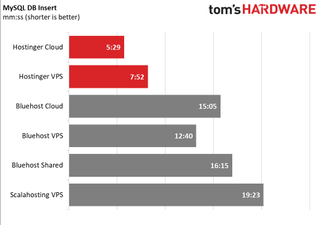
Its WordPress Hosting Benchmark score of 7.4 was not the highest we’ve seen but it is more than adequate for running a speedy content site. It delivered a strong 23 requests per second when hit with 500 concurrent requests, among the upper tier of VPS plans.
To get a VPS plan at prices that are this competitive, you do have to either accept a small trade-off or pay a bit more. When you activate your plan, you’re given a choice of operating systems and control panels to install on your server and, if you choose cPanel / WHM, you have to buy an additional license which costs at least $22 a month. cPanel is, by far, the most powerful and easy-to-use site control panel and WHM is the best for managing the server itself (doing reboots, creating accounts, installing software).
However, the good news is that you can live without cPanel. Hostinger offers a combination of VirtualMin / Webmin panels for free. While these tools are more difficult to navigate, they perform pretty much the same functions and don’t add cost.
Read: Hostinger Review
Best Cloud Hosting

2. Bluehost Cloud Plans
Specifications
Reasons to buy
Reasons to avoid
If you expect to get a lot of traffic on your website, a Cloud plan will give you more resources to serve those requests. And, of all the Cloud plans we tested, Bluehost’s was the fastest. We tried the very basic $29 / month, Cloud 1 Plan and found that, on our Apache tests, it was able to deliver an amazing 1,578 requests per second when hit with 500 concurrent requests, an amount that not every hosting plan can even handle. At 100 concurrents, it delivered a stunning 1,220 requests per second. That’s nearly 5 times faster than any other plan we tested on any service.
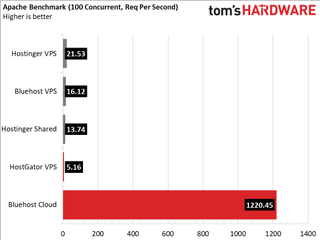
Bluehost’s Cloud plans start at a reasonable $29 and go all the way up to $119 a month with a one-year commitment. After that, the prices go up a bit. Our entry-level plan had a mere 10GB of storage space, but you can go up to 225GB if necessary.
Unlike with VPS, you don’t get admin rights to the server and you don’t get cPanel to control your server, but Bluehost’s own built-in admin interface is more than adequate to get you access to WordPress, to setting up shell access and to the database, which happened to be MariaDB 10.6 at the time of testing.
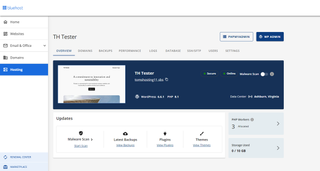
Though you don’t get admin rights to your server, you can log in to the terminal via SSH. And, in doing so, I was able to execute a shell script that ran for at least 3.5 hours (after which I stopped it). That’s good because some plans will kill your script after just a few minutes, making long-duration tasks such as scraping a website or performing a complex database import impossible.
In our tests, the Bluehost Cloud plan handled two out of three of our MySQL Database tests with aplomb but it was overwhelmed by and timed out on our third and most intensive workload which joins two giant tables and sums data across millions of rows and columns.
However, if you’re using the server for hosting a content site such as one based on the WordPress CMS, the ability to serve pages is the most important thing. Bluehost’s Cloud hosting plan not only can handle a lot of requests but it scored a very strong 8.5 on the WordPress Hosting Benchmark, which is one of the highest scores we’ve seen.
Read: Bluehost Review
Best Shared Hosting

3. HostGator Shared Plans
Specifications
Reasons to buy
Reasons to avoid
If you are just building a simple website to showcase your resume or a very small business (without an online store), a shared hosting plan is your best bet. HostGator offers shared hosting plans starting at less than $3 a month with a three-year commitment. All of the plans have “unmetered bandwidth,” which means you don’t get charged extra or cut off if you go above a traffic threshold. And, as with even the cheapest shared plans, you get the ability to host and make free email accounts with your domain name on them.
I tested the $3.50 / month Baby Plan that promises 2 vCPUs, 20GB of storage, and Cloudflare CDN for faster page loading. You can even have 10, 20 or 50 websites on a single account. Overall, I was pleased with how easy it was to set up features such as SSL for domain, though I was frustrated that HostGator seemingly wouldn’t support domains with the .sbs top-level domain that we use for testing and we had to register a different one with a .site extension (a regular “.com” or “.org” should do fine).
However, the message here is that the presence of cPanel makes HostGator really easy to operate and set up. Installing WordPress is a breeze and so is doing things like setting up SSH access.
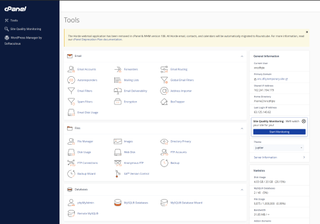
If you’re after the best performance you can get from a shared plan, HostGator may or may not fit the bill. It scored a solid 7.3 on the WordPress Hosting Benchmark and it capably handled all of our database benchmarks. However, when we ran our Apache traffic test, the server couldn’t handle 500 or even 100 concurrent requests. At 10 concurrent requests, it delivered a modest 6.1 requests per second. But that’s fine for a personal blog, a resume site or one meant to promote a small business.
Read: Hostgator Review
Best WordPress Hosting

4. ScalaHosting WordPress Plans
Specifications
Reasons to buy
Reasons to avoid
ScalaHosting isn’t the best-known name in web hosting, but it offers some really affordable and highly functional plans. Its WordPress hosting plans, which are shared hosting plans but come with WordPress pre-installed, are a particularly good value and are able to handle a lot of traffic.
The company’s WordPress plans start at just $2.95 with a 36-month commitment and just 10GB of storage space, but they ramp up to 100GB of storage if you’re willing to pay $9.95 a month. We tested the low-end WP Mini plan and were impressed with its ease of setup and ability to handle lots of concurrent traffic.
One of the problems we see with a lot of shared plans is that they can’t handle a lot of concurrent requests. That means that if you get a burst of traffic, some of your users may not get served or may be waiting a very long time to see your page. ScalaHosting’s WordPress hosting plan was able to withstand the Apache Benchmark where I threw 500 concurrent requests at it and it delivered a solid 13.4 requests per second, which is not the world’s fastest, but neither Bluehost nor HostGator’s shared hosting plans could even handle this amount of traffic.
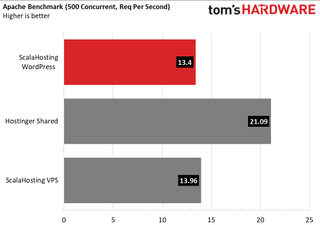
ScalaHosting’s WordPress hosting performance on our database tests was not spectacular, but it actually completed all the tests with its MariaDB 10.6 application, while competitors such as Bluehost timed out on the third and most intense test, which involves a massive table join and sum action. It also got a very mediocre score of 5.3 on the WordPress Hosting Benchmark.
The plans come with cPanel, the most powerful and easy-to-use control panel around. And that makes it easy to do things like enable SSL, create email accounts, and handle subdomains. Shell access is disabled by default, but I made a support request to have it turned on and Scalahosting’s support staff enabled it for me without complaint.
In fact, ScalaHosting’s support is some of the best I’ve seen, because it has a simple ticketing system you can use to ask for help with problems. Then you can go about your business and check back in later to see the tech’s response. Most hosting plans I’ve tested require you to use a live chat to file requests, which is slow and frustrating because you have to sit there for 30 minutes or more as you wait for responses and for your request to be escalated to the right person. If it’s not a 911 emergency, you’re better off filing a ticket.
Overall, if you’re looking for good capacity, ease of use, and support, ScalaHosting’s WordPress plans fit the bill.
Read: ScalaHosting Review
Best VPS Performance

5. Liquid Web Managed VPS Plans
Specifications
Reasons to buy
Reasons to avoid
If you want a ton of performance and flexibility in a VPS plan, Liquid Web’s Managed VPS plans should be near the top of your shopping list. While they aren’t quite as cheap as Hostinger’s, Liquid Web gives you a ton of configuration options at very reasonable prices. And performance in my testing was fantastic.
As with Hostinger, cPanel does not come standard but is available as an add-on for at least $28 a month. Instead, we used the Interworx / Nodeworx control panels that come at no additional cost, but are harder to use and less powerful than cPanel / WHM. Still, they are functional enough to perform the tasks web developers need most, like creating databases, turning on SSL, and enabling SSH for user accounts.
Liquid Web offers a very wide variety of Managed VPS plans – managed in this case means that they handle server maintenance and upgrades which is common for most hosts. These range from a $20 / month plan that comes with 2 vCPU cores, 2GB of RAM, and a 40GB SSD up to a $55 / month plan that has 16 vCPU cores, 12GB of RAM (or 16GB with 12 cores) and a 200GB SSD. Those are some really good prices, though each one is limited to 10TB of bandwidth per month, which is probably a lot for most people, but competitors such as Hostinger have VPS plans that go up to 32TB of bandwidth or unmetered.
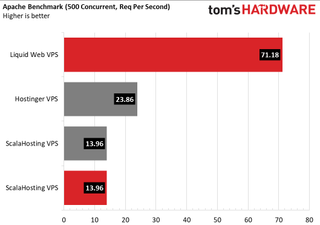
We tested a plan with 4 vCPUs, 4GB of RAM, and 100GB of storage and it turned in really strong performance on all of our tests. On the WordPress Hosting Benchmark, it scored 8.4 out of 10, which is one of the highest we’ve seen on any plan. Its Maria 10.6.18 database completed all three of our database tests at epic speeds. And it delivered 71.18 requests per second when we hit the server with 500 concurrent requests.
Best Cheap Shared Web Hosting

Specifications
Reasons to buy
Reasons to avoid
Shared hosting plans can be inexpensive, but Namecheap blows away the field with a $1.98 / month base plan that’s the least expensive we’ve seen. Normally, for bargain basement prices, you’d expect mediocre performance, but this one actually scored higher than the company’s VPS plan on our MySQL database tests, completing massive queries with ease.
Where many shared hosting plans and even some VPS plans can’t handle a lot of traffic, Namecheap’s shared plans aced the Apache Benchmark where we hit it with 500 concurrent requests. Its ability to deliver 26 requests per second beat out Hostinger and ScalaHosting’s VPS and shared plans.
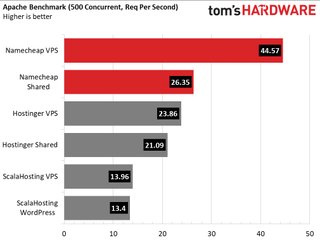
Another huge benefit: Namecheap’s plans don’t have a shell script timeout like most other shared hosting plans we’ve tested. That means that, if you need to run a huge database import or other procedure at the command prompt, you can do it and not fear that the system will kill your script after 10 or 15 minutes.
The only real downer to Namecheap’s shared plans is that they only come with one year of free SSL, the process you need to make sure your site can use https, a requirement for any website these days. After that, the company wants you to pay for SSL certificates, something other web hosting plans we’ve tested never charge you for. However, there are ways to get free certificates (a service called Let’s Encrypt is the leader) if you don’t use their tools to do it.
Read: Namecheap VPS and Shared Hosting Review
Best Web Hosting Shopping Tips
Best Web Hosting Shopping Tips
When shopping for the best web hosting plan for your home or business project, consider the following:
- Don’t fear commitment: Most plans offer a low, per-month cost but, to get it, you must agree to a two, three or even a four-year commitment. After that term is up, prices get much higher and you may want to switch providers. Since this is commonplace, you’re better off agreeing to a long-term plan and locking in that low price for a while.
- Watch database size limits: Some plans impose a size limit specifically on your MySQL databases that is not published in the specs. So, you might sign up for a plan that says you have 200GB of storage space and then learn you can’t have a database that takes up more than 5GB. Read all the fine print. We’ve noted this problem in many of our reviews.
- Register your domain elsewhere. If at all possible, use a separate registrar such as Namecheap or Go Daddy for managing your domains rather than registering them through your hosting provider. That way, when you want to switch providers, you won’t have a hassle.
- cPanel is a huge plus because it’s the easiest and most powerful control panel, but you can save money by choosing a plan that doesn’t have it.
- Stick with Linux: Unless you have a special application that requires Windows Server, which is doubtful, stick with Linux as your hosting OS, which is what most plans use. In fact, most plans use either CentOS or Alma Linux, which are both good flavors for serving.
- Email is easy: Every plan comes with email: Pretty much every plan comes with the ability to create multiple email accounts on your domain and to store messages in the cloud. If you plan to dozens or hundreds of addresses, you may want to look at the fine print. But, for most people, the email service is more than adequate on any plan.
How We Test Web Hosting Plans
How We Test Web Hosting Plans
To see how each hosting plan stacks up, we register for an account and go through the process of assigning our domain name to it – we usually use domain names that are hosted by an outside registrar (Namecheap), enabling SSL and installing the latest version of WordPress CMS (if it doesn’t come preloaded).
To benchmark WordPress itself, we run the WordPress Hosting Benchmark, a plugin that gives you a score in the 0 to 10 range (10 is best) based on criteria such as database performance, network speed, etc. We also use an Apache test to hit the server with 500 concurrent connections and see how many requests per second it can deliver; if it can’t handle 500 concurrents, as is often the case (sometimes due to security restrictions), we drop it down to 100.
It’s also really important to determine how quickly a hosting plan can handle complex database queries. Most websites, including those built with WordPress, rely heavily on MySQL or MariaDB, a MySQL-compatible database. Later versions of both applications tend to provide better performance as do servers with more resources dedicated to your account.
To test database speed, we conduct three intensive MySQL queries. In the first, we insert 87 million rows of data drawn from historical traffic data on our site, with each page having an entry in one table and multiple page view entries by date in another table. This is a massive insert that uses more than 4GB of disk space; some plans that have database size limits can’t handle it. After the insert, we do a number randomization test where our script goes through each row and replaces its original traffic data with sets of random numbers.
Our third database test involves a massive query where we join the traffic table and the articles table in order to get a sum total of page views, entrances, and other traffic numbers for each article. This is usually the most intense of the three tests and some servers time out rather than completing it.
Speaking of timing out, we also run an “endless script,” which is just a bash script that writes the time elapsed to the log every minute. We check back on it after several hours to see if it is still running or if the system has killed it. Many hosting plans have a short time limit after which they kill scripts. If you are doing a major operation such as scraping a website or conducting a giant database query, you don’t want time limits.
Stay On the Cutting Edge: Get the Tom's Hardware Newsletter
Get Tom's Hardware's best news and in-depth reviews, straight to your inbox.